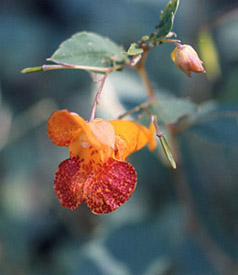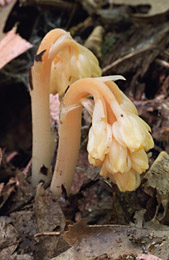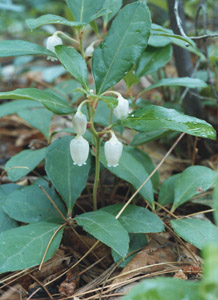
Jewelweed or Spotted Touch-Me-Not, Touch-Me-Not family (Balsaminaceae), Native

|
From mid-July through mid-September, jewelweed (Impatiens capensis) blooms in moist, partly shady areas of the Reservoir, particularly along streambanks. The numerous orange blossoms dangle like jewels from delicate stems. They develop into quarter-inch seed pods that pop open at a touch when they are ripe, providing great fun for kids and flinging seeds up to four or five feet away. These active seed pods give rise to the plant's other name, spotted touch-me-not.
Some people use jewelweed to treat the itch and rash from poison ivy. They pick leaves
and rub them on the affected skin, or they boil the plants in water and put the liquid on the rash.
Various Native American tribes used the plant for an assortment of skin ailments.
Pinesap, Wintergreen or Pyrola family (Pyrolaceae), Native

|



|
Checkerberry is the "wintergreen" that has been a source of oil of wintergreen, used in the past as a flavoring agent. Traditionally it was also applied externally to relieve bodily aches and pains. A tea from the leaves was used for colds, fevers, headaches, and stomach aches.
Broken leaves give off a recognizable wintergreen scent and have a wintergreen flavor. The chemical responsible for this wintergreen aroma and taste, methyl salicylate, is related to aspirin. This chemical is now made synthetically for commercial uses, such as flavoring.
Checkerberry is in the heath family (Ericaceae), along with blueberries, azaleas, and rhododendrons.
| show TOC frame | Table of Contents | 
|
| Home / Contact | ||
Copyright © Anne A. Reid, 1999-2002. Photographs copyright © Garry K. Kessler, 1999-2002. | ||